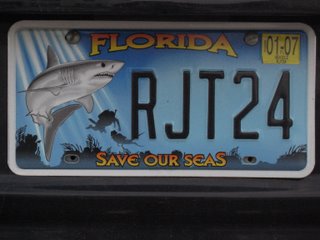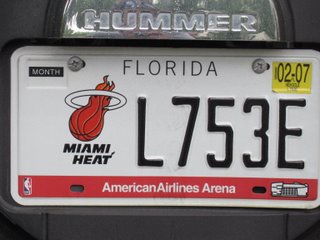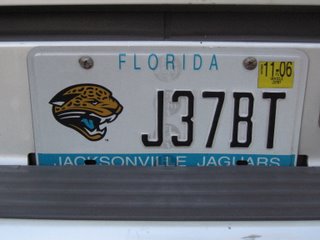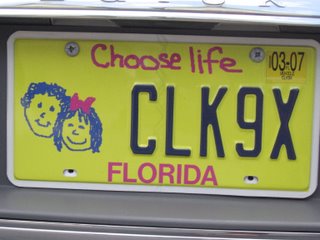
This isn't real, obviously.
It's surprising that, during my first hour in Celebration, I find the town kind of pleasant. Well, not kind of—pleasant, despite the oppressive humidity that hasn't let up since I left Gibsonton. This is surprising for two reasons. First, that Celebration is a new, planned community. Second, that its developer is the Walt Disney Company.
I have nothing against Disney in particular. I may or may not be a stockholder, in fact, because my grandmother used to buy my brother and I small bits of stock— shares, or 7 shares, or 1 share—as Christmas presents, leaving the nicely printed and embossed certificates in 8 ½ x 11 envelopes (or occasionally in No. 10's) for us to not play with and give to Dad to put in a safe deposit box. Still, can you imagine living in a community where the wreath on your door is not a standard circle, but three circles joined together to look like Mickey Mouse ears?1
Actually, I have something against Walt Disney, but Walt Disney the man, not Walt Disney Company. Jerome Pohlen's Oddball Florida, which has an entry on Celebration, quotes Walt Disney's vision for EPCOT, that Experimental Prototype Community Of Tomorrow, as “a city that caters to the people as a service function. It will be a planned, controlled community. . . . In EPCOT there will be no landowners and therefore no voting control. People will rent houses instead of buying them. . . . There will be no retirees. Everyone must be employed.” In the 50s Walt was also a rapid “anti-communist,” meaning that he was friendly to Joe McCarthy and House Un-American Activities Committee.
Instead of becoming what Pohlen calls a “voterless, work-until-you're-dead” paradise, EPCOT effectively became a branch of Disneyworld (sp?), and Disney's plans were unfulfilled. Until Celebration, that is. But Celebration doesn't share much of Walt's ideas, instead buying into New Urbanism, the idea that people are actually happier in communities that are walkable, denser, and less sprawling. And this is why, I think, Celebration seems so nice for what it is.

“I thought you might be pulling out before,” says a middle-aged man in a blue polo shirt outside of the Cafe d'Antonio. Celebration isn't really short on parking, but if you need to park less than a block from your destination, sometimes it can involve a lot of waiting. “Your car, I mean, in the parking lot. I thought I could just follow you to a space.” The man is smoking a cigarette casually and looks like he's on break.
Which he is. His name is Steve and he's the Entertainer for a timeshare company, taking the prospects all around town, though he tells me that he makes most of his money these days by flipping real estate, buying properties on eBay and then selling somewhere else. When I ask him why he sells timeshares, he shrugs and says that it's steady, and easy.
Entering Celebration you drive along a long, green stretch of Highway 192, marked by regular palms and, if you look closely, regularly spaced curb cuts. It's actually quite charming, and gives space to the town that adds to its appeal: The space makes the town feel like a discrete area, like a town. But the curb cuts are suspicious.
“I saw the cuts in the sidewalk coming in,” I say and describe the road. “Is all that going to be developed?”
Steve takes a last drag from his cigarette and heads back inside. “Disney'll always develop every square inch they can get their hands on,” he says. “You can count on that.”

Market Street, after two hours in Celebration, is the beginning of my disenchantment. Market Street is the main commercial drag, mixed-use, with housing above the shops, and parking hidden behind the buildings. It's very walkable, and to encourage that, music, mostly smooth jazz, comes from speakers in the sidewalk. Except that it's irritating, and things don't feel very real. But what's there, however bland it is, is not nearly as important as what's not, and indeed, what the town doesn't have at all.
Market Street:
and across the street, moving up now:
So it's mostly souvenirs. But the town doesn't have a hardware store, doesn't have a pharmacy, doesn't have a supermarket. That is, for all the New Urbanist speak, the town is missing the very things that a town needs to survive.
Actually, I misspeak. Let's be fair: The town is missing the very things that people need to survive.
1 Actual Celebration wreaths do, on occasion, look like this.
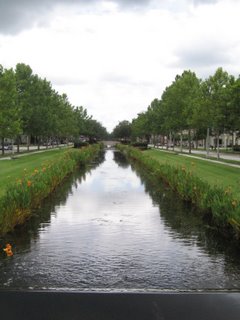


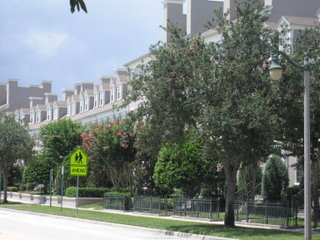
I am officially calling shenanigans on the Gulf. Water warm enough to bathe in—what's that? I'll tell you what it is—it's an ocean for the weak.




It was in 1869 that Cyrus Teed had his “divine illumination.” The time, generally speaking, was right for divine illuminations: Teed's contemporaries, groups like the Mormons, the Harmonists, and the Oneida Community, all began based on communal property and a certainty that God's work was not yet being carried out on earth. Of course, one former member of the utopian Oneida Community—a man named Charles Guiteau—shot President James Garfield because God commanded him to.
In any case, while the Koreshan Unity began in New York, as did the Mormons, the Oneidans, and many others during the Great Awakening, the Koreshans quickly moved to Chicago. From there, after a gift from homesteader Gustav Damkohler, Teed moved the group to Estero in 1896 to form the New Jerusalem.
Teed was a bit kooky, but his heart was in the right place. He believed himself immortal, for one thing, and when he died in 1908, his followers waited up for days for him to, well, resurrect himself. It didn't happen, and eventually they buried him. For another, he preached that the earth was actually the inside of a hollow sphere with the sun in the middle, which at least one of his members believed until the moon landing in 1969.
Still, many of his ideas are attractive, and the Koreshans did not produce even a failed presidential assassin.1 Teed encouraged learning and the arts, and the Koreshans had schooling for their children, lectures on subjects from music composition to osteopathy, and planned for a lending library, though it was never built. Additionally the Art Hall held orchestra concerts, theater productions, and all sorts of other events for the happiness of the settlers.
But the Koreshans, obviously, died out. The last four members deeded their land to the State of Florida in 1961 in Teed's memory, and the State has since preserved the buildings and grounds to a reasonable degree. But why did the Mormons thrive in Utah and the Koreshans fail in Florida?
The answer, I think, is in reproduction, specifically that the most fervent Koreshan believers did not reproduce while the most fervent Mormons had more children than fingers. Teed divided the Koreshans into two orders: the Cooperative Order, whose members lived outside the settlement and could maintain their families; and the Religious Order, whose members were divided by sex, required to live in the settlement, and celibate.
The Koreshans never numbered more than a few hundred, if that many. With no or few little Koreshans running around, Teed's grand city—New Jerusalem was supposed to be able to accommodate 10 million people—and his grand new religion failed to leave behind more than a handful of machinery, wood frame buildings, and a population of adherents who could protect the settlement from the huge, amoebic strip mall that is growing across the road.
1 On the other hand, the Oneida Community became Oneida, Ltd., which still makes dinnerware today.
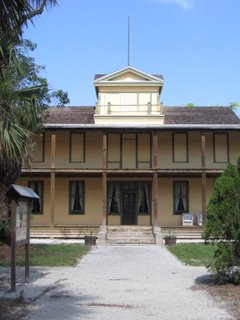
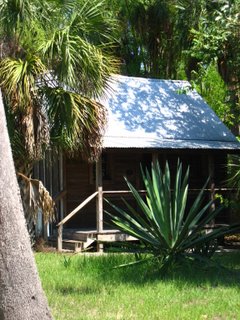

It is my sincere belief that Florida leads the nation in license plates. Numerically, that is. Michael's father—Michael's entire nuclear family has since arrived, and the five of us are now sharing Michael's two-bedroom condo—claims that Florida license plate templates cover the walls of the branches of the Florida DMV, every possible plate there for you to see and compare and buy. Further, there are an impossibly high number of these, he says, a thousand, perhaps. I am a little doubtful that there are this many, but they are everywhere.
What to make of this? No moral, just a contrast.
Florida's view is that the state shouldn't give up easy sources of revenue, like these plates for the Jacksonville Jaguars or Support Education or Save the Manatees or what-have-you. If the customer—here, the driver&$8212wants it, and it is of no additional cost to the state, only good can result. It is, in essence, economics at work.
The other view is that the state is not for sale.

